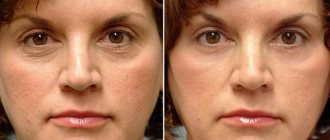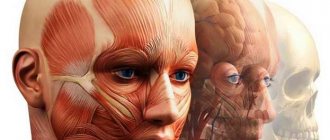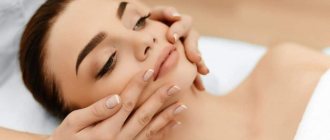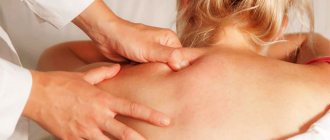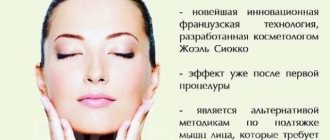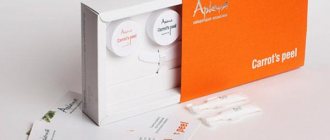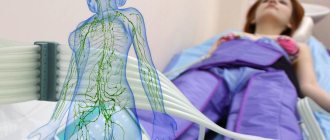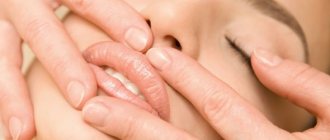It is recommended to get rid of many cosmetic appearance problems only after consulting a doctor. Swelling, dark circles, increased sagging skin, enlarged pores are often a consequence of poor health. Therapeutic effects, such as myofascial facial massage, together with traditional therapy will give an amazing effect. The technique is difficult to perform, but can even simulate an oval without the “circular lift” operation. It is useful to learn more about the impact technique. It is rarely possible to correctly repeat manipulations at home.
Tatiana Shubina's technique
Myofascial massage, affecting the face and head, consists of manual manipulation aimed at intense muscle relaxation. During the session, the master works not with muscles in the broad sense, but with fascia (the membranes of the muscular body).
The technique is not widely used. The circumstance is explained by the complexity of mastering the impact technique.
Tatyana Shubina, an experienced specialist in sports rehabilitation, trainer for therapeutic and preventive effects, cosmetologist, author of a unique myofascial technique, created her technique, guided by numerous knowledge in the field of massage. The masters were inspired by the manual practices of massage therapists in India.
During the implementation of Shubina’s technique, attention is paid to intensive study of the tendon helmet of the skull and ear area. The actions help to qualitatively restore impaired blood circulation, lymph flow, regulate the tension of the facial muscles, activate the processes of tissue regeneration, the production of collagen and elastin necessary for the skin.
Important! The technique is based on the professionalism of the master and the ability to correctly apply existing knowledge. The sensitivity of the massage therapist's hands matters. During the exposure, it is important to identify immobile areas, stagnant processes, fibrotic phenomena, deep muscle “strands”.
Impact of massage
Massage promotes the following physiological changes:
- Massage movements relieve tension in the central part of the supracranial muscle.
- The calvarial (frontal) muscle, whose main function is motor, is strengthened, which makes it possible to remove transverse wrinkles on the forehead.
- Lymph flow increases, fluid outflow from tissues improves and, as a result, swelling is reduced.
- The pathological age-related weakness of muscles and nerve tissues inherent in the double chin is removed - the accumulation of fatty tissue under the mandibular bone, sagging under the chin.
The work of a massage specialist wearing gloves gives the patient an emotional feeling of relaxation, liberation, and relief. With this stimulation, the processes of intensive renewal of the skin, their full functioning, and, consequently, true rejuvenation and overall firmness of the form are launched.
This massage technique changes the condition of the deep structures of the skin, and a positive anti-aging effect is manifested. The technique does not contradict and even accompanies any other procedures aimed at aesthetic changes in appearance.
Efficiency of technology
The effectiveness of the myofascial massage procedure directly depends on the professionalism of the master. Skills, experience, competent reproduction of technology will give results:
- relieving muscle tension and pain;
- disappearance of dizziness, migraines;
- normalization of the emotional sphere;
- activation of hair growth, solving problems of the scalp;
- achieving skin and muscle tone;
- improvement of color and relief of integument;
- smoothing facial wrinkles;
- minimizing swelling, dark circles, congestion;
- elimination of sagging, asymmetry.
Efficiency largely depends on the initial condition of the skin, the “neglect” of destructive processes, existing health problems, and the patient’s age.
The following signs will indicate that it is useful to perform a course of myofascial massage:
- a swollen, deformed oval (double chin, jowls, drooping part of the face);
- age-related changes (wrinkles, sagging skin);
- weakness, decreased muscle tone;
- deterioration in the quality of appearance (swelling, change in skin color, loss of “freshness”).
Myofascial massage is considered a non-traditional therapeutic procedure. It is advisable to use this method after consulting a doctor.
Rules for performing the procedure
Myofascial massage is characterized by its effect on the fascia (shells, muscle spaces). Not only the facial muscles are involved, the entire skull and neck are involved. The impact occurs by means of mechanical coupling.
The usual gliding is not performed. No cosmetic products are used during the massage. This provides a qualitative determination of the location of fibrotic phenomena, areas of lymph stagnation, and deep muscle “cords”.
The procedure, carried out according to all the rules, helps to improve the elasticity and flexibility of the fascia. Thanks to this, the muscles regain their ability to function at full strength.
Myofascial massage effectively relaxes, minimizes pain, and eliminates spasms. The effect is compatible with other cosmetic procedures that promote rejuvenation.
Attention! An important rule in performing the procedure is maintaining contact with the patient. It is expected to move the body position and normalize breathing. Competent palpation is required on the part of the fascial technique master. Knowledge of anatomy and hand sensitivity play an important role in achieving results.
The best effect can be achieved by performing a full myofascial massage. The procedure begins with an impact on the skull, the next area is the neck, proceeds to work with the facial muscles, gradually moves to the shoulders, paravertebral areas, and completes the massage with an effect on the lumbosacral region.
Myofascial massage - what is it, effectiveness
The goal of myofascial massage is absolute muscle relaxation by influencing the superficial connective tissues located under the layer of skin and subcutaneous fat. It is performed on the face, back, arms, legs, neck, shoulders, and abdomen.
Fascia of the back
Due to the pressure on the fascia produced by the specialist during the procedure (the main movements are stretching, twisting, squeezing the muscles), blood circulation and lymph movement in the body are stimulated, the fascia becomes more flexible, elastic and mobile.
Sudden movements, bruises, and sprains can lead to muscle spasms and activation of trigger points. These processes are accompanied by severe pain. Myofascial massage in these cases is used as a therapeutic method, because... it allows you to get rid of the consequences.
In addition, it is recommended for athletes and training people to prevent such injuries and increase the efficiency of muscle function in general.
Myofascial massage is indicated for activation of trigger points as a result of muscle spasm after a bruise or sprain. What are these points, the massage of which allows you to get rid of pain, is shown in the diagram.
It is remarkable that myofascial massage is also a procedure that has a powerful cosmetic effect; it is used to correct the contours of the face and figure, combat signs of aging, excess weight and cellulite.
Patients who have undergone a course of professional myofascial massage note the following changes:
- The general condition improves: headaches go away, heart rate normalizes, and a surge of strength is felt;
- After a massage session, a feeling of lightness comes, the pain recedes;
- The cosmetic effect is obvious - the skin takes on a healthy, toned appearance;
- The functioning of the nervous system is normalized, sleep improves, and mood improves.
Face massage
In cosmetology, myofascial facial massage is considered a full-fledged alternative to such surgical services as a circular lift.
The advantage of this technique is that it allows you to achieve an impressive effect not with the help of a knife, but through the skillful hands of a qualified craftsman with deep knowledge of anatomy.
Myofascial facial massage is indicated if there are signs of skin aging, enlarged pores, swelling, and a double chin.
In addition, experts recommend that women over 35 years of age systematically resort to this technique for preventive purposes; in this case, myofascial massage will help preserve youth for a long time.
During the sessions, the specialist carefully works out the muscle tension on the face; all movements are made only in the direction of the muscle fibers and are light in nature (pinching, twisting, stroking the skin).
After facial massage sessions performed using the described technique, the following changes are noticeable:
- Relieves muscle tension, as a result of which wrinkles disappear, folds on the forehead are eliminated, and the contour of the face changes;
- Blood flow and lymph movement increase, due to this the skin takes on a healthy, fresh appearance.
Head and neck massage
Myofascial massage of the head and neck is carried out in combination with facial massage, unless there are individual contraindications to this effect.
Trigger points of the head and neck
The specialist begins with intense circular movements on the scalp, then moves on to kneading and stroking the forehead and temple areas. The other hand simultaneously massages the neck. This technique allows you to get a number of positive results:
- Relieving tension and pain in the muscles of the face and neck.
- Noticeable improvement in the overall condition of the skin (color, tone, relief).
- Improved well-being (elimination of dizziness, headaches).
Back and lower back massage
It is also noteworthy that myofascial massage is not a purely cosmetic procedure; its important advantage is the obvious healing effect.
Myofascial back massage is aimed at developing trigger points and relieving pain, increasing spinal flexibility, and stimulating blood circulation.
Location of trigger points on the back and lower back
Before the session begins, the specialist determines the direction of the muscles, then begins the massage from the neck area with a gradual transition to the lumbosacral region. Patients are advised to breathe slowly and calmly during this time.
It is important to note that back massage can only be performed by people with special education, otherwise the procedure may have a negative impact on the functionality of the spinal column.
Massage of legs, thighs, shins
In the professional sports environment, it is believed that myofascial massage of the legs, thighs, and lower legs is an effective way to achieve complete muscle relaxation, increase flexibility, and relieve pain. You can do it yourself using a small ball (like a tennis ball) or a hand-held roller massager.
The technique is very simple: you need to lightly press on the tense area of the muscle with a massager or roll it until you feel relaxation. The procedure is recommended to be carried out when preparing for physical exercise at the warm-up stage, as well as before stretching exercises.
Don't miss the most popular article in the section: Laser hair removal on the face and body - how it is done, effectiveness, before and after photos, contraindications.
Shoulder massage
In cases of injuries and diseases of the shoulder joints, as well as in cases of glenohumeral perarthrosis, a course of myofascial massage of the glenohumeral joint is recommended. This type of treatment should only be carried out by a professional.
To prevent such problems, as well as to improve the mobility of the shoulder joint, experts recommend performing self-massage using myafascial rollers and rollers.
Abdominal massage
Myofascial massage of the abdomen is aimed at cosmetic correction of its shape and volume, as well as improving the functioning of the gastrointestinal tract. Such effects are achieved through a deep and rapid effect on all fibrous tissues, as well as through stimulation of blood circulation processes.
Preparing for the session
When preparing for a session, it is advisable to normalize your emotional state, organize your thoughts, and relax. Before the procedure, it is necessary to cleanse the skin. The presence of decorative or skincare cosmetics is unacceptable. The master works with the inner layers of fabrics. To reach them, proper “grip” with the skin is required.
The work happens not only with the facial muscles. The master touches the scalp. The hair must pass freely through the massage therapist’s hands. To do this, the hair is completely freed. Tight hairstyles are excluded.
Posture is important to work properly with fascia. The best body position: lying down. The master dictates what pose to take, turn, lower your head.
Contraindications
As an intervention that can change the functioning of the body, the myofascial technique of facial massage has its contraindications and prohibitions. Among them:
- oncology;
- herpes;
- eczema;
- thinning of the walls of blood vessels;
- atherosclerosis;
- rosacea;
- moles, papillomas, nevi;
- allergic, infectious diseases;
- fresh wounds, injuries, burns, insect bites;
- facial nerve damage;
- increased body temperature;
- hypertensive crisis.
It is forbidden to massage after a peeling or mesotherapy session performed the day before.
You should definitely notify your doctor about other acute or chronic diseases not included in this list, who will decide on the advisability of the procedure.
Execution technique
The procedure begins with a conversation. The master needs to collect the maximum amount of information (complaints, illnesses, body characteristics). Having understood the state of affairs, the massage therapist begins to “study” the work space.
By palpation, problems are identified: stress points. Based on the information received, the master selects appropriate ways to solve existing difficulties.
The active effect begins from the scalp. The master works with intense circular movements at a fast pace, relieving excessive tension in the tendons. With varying pressure, the lateral surfaces of the skull are worked in the same way. The forehead and temples are subject to influence. The rods located on the head are processed.
In parallel with the skull, the neck is warmed up. The movements are palpable, circular, similar to rubbing, “rolling” the skin. The master operates with two hands. There is kneading and deep stroking of the muscle systems. After working on the forehead and temples, they proceed to the chin area. The front area of the neck completes the training of “minor” zones simultaneously with the behind-the-ear space.
Maximum attention is paid to the face:
- Using circular movements of the fingers, the points located on the chin under the corners of the mouth are worked out. The movements are strong and affect deep layers of tissue.
- Move to the line from the corners of the mouth to the cheekbones. Actions with increasing intensity: stroking is replaced by moving pressure. The line is worked in 2 directions. When moving from the cheekbones, the pressure is stronger, turning into vibration, imitation of pinching.
- Affects the eyelid area. There is a “rolling” of the skin. The movement begins from the outer corner of the eye. Walking in a circle.
- Move to the line from the bridge of the nose to the temples. The movement is characterized by deep pushing. The move in the opposite direction is stroking, alternating with pinching.
Facial tissues are handled with care. The movements are smoother and easier than when processing the skull. The movement of the fingers is determined along the muscle fibers.
Video: myofascial massage of the face and head - master class led by Tatyana Shubina, teacher of original manual techniques.
Massage at home
Despite the ongoing debate between supporters and opponents of self-massage, with regard to myofascial techniques, the number of the latter is much larger. Due to the complexity of the procedure and the need for training in physiology and anatomy, experts do not recommend performing the procedure at home. One wrong movement can significantly worsen the patient’s condition and cause serious harm to health.
However, with special devices - a ball, foam roller or roller - self-massage is still possible.
The main thing is to carefully study the rules of their use and self-massage lessons, and also avoid self-massaging the neck and collar area - this area should be entrusted to a specialist.
Course duration
The introductory exposure lasts no more than 40 minutes. Subsequent sessions increase to 60–90 minutes. The effectiveness of the procedure is noticeable after the first exposure. Tension goes away, congestion and swelling disappear, skin quality improves, muscles become toned.
To achieve global transformations, 7–10 sessions will be required. It is advisable to distribute the procedures 1-2 times a week. It is recommended to take no more than 2 courses of myofascial massage per year.
Advice. To maintain the effect, it is advisable not to overstrain the muscles, giving them a moderate load. It is recommended to monitor facial expressions, weight gain, health, and take good care of your skin. Procedures that promote rejuvenation can enhance the cosmetic effect of myofascial massage.
Session cost
The price of the procedure depends on the areas involved and the problem being solved. The salons practice an individual approach to patients. The cost of a single session varies between 1500–3500 rubles. When implementing an integrated approach to shaping your appearance, many establishments provide discounts.
Trying to perform the procedure at home is not recommended. To correctly reproduce the technique, special knowledge is required. An existing massage therapist needs additional training to work using the technique.
To obtain a high-quality result, it is recommended to contact a specialist who has experience working with myofascial techniques and has positive customer reviews.
Where is myofascial massage performed? Results of the procedure and frequency. Price
Professional myofascial massage should be performed by a highly qualified physiotherapist or cosmetologist in a specialized clinic or beauty salon, only then will all the desired effects be achieved with its help.
Experts in the field of beauty recommend that before coming to an appointment with a particular specialist, carefully study the documentation of the chosen institution, its rating and real reviews from other patients.
If myofascial massage is performed by a master of his craft, then the result of the action is felt after the first procedure. The required number of sessions depends on the nature of the problem being solved and is determined by the doctor individually. Traditionally, a full course consists of 10 sessions.
The price of myofascial massage may vary depending on the region, as well as the level of the master and the clinic. The cost of one procedure on average ranges from 1,500 to 5,000 rubles.
Precautionary measures
Improper performance of myofascial massage can have a detrimental effect on health and appearance. Incorrect grips of the fascia are fraught with sprained ligaments and pinched nerve endings. Possible damage to blood vessels and soft tissue injuries. Wrong actions will aggravate the age-related picture. Instead of smoothing out wrinkles, they will deepen and become dispersed across the face. Loose skin can stretch and sag.
When performing procedures, it is recommended to carefully consider the presence of contraindications:
- oncology;
- musculoskeletal injuries;
- various formations on the skin (moles, papillomas, herpes);
- problems with blood vessels;
- increased blood pressure;
- skin rashes of various types (acne, allergies);
- inflammatory processes;
- damage to the integument;
- pathologies of the facial nerves.
It is not recommended to perform myofascial massage during pregnancy. An exacerbation of any chronic disease is a reason to postpone the procedure.
Myofascial massage is an alternative option to expensive cosmetic and surgical interventions. The impact will become the basis or addition in the formation of the desired appearance.
The essence of the method
The main difference between the procedure and a regular massage is the effect not on the skin itself, but on the tissues located between the muscles. More precisely, on the connective tissue - fascia. The skin has a deep regenerative effect, which, by relaxing muscles, relieving tension, eliminating many aesthetic problems. Tension is relieved by working out trigger points - places where muscle spasms and tension are concentrated.

